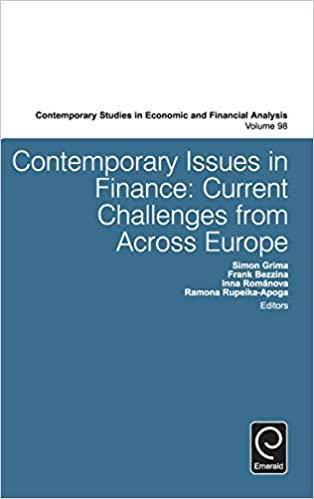Question
Stock X has a 10.0% expected return, a beta coefficient of 0.9, and a 30% standard deviation of expected returns. Stock Y has a 12.0%
Stock X has a 10.0% expected return, a beta coefficient of 0.9, and a 30% standard deviation of expected returns. Stock Y has a 12.0% expected return, a beta coefficient of 1.1, and a 30.0% standard deviation. The risk-free rate is 6%, and the market risk premium is 5%. The data has been collected in the Microsoft Excel Online file below. Open the spreadsheet and perform the required analysis to answer the questions below.

-
Calculate each stock's coefficient of variation. Round your answers to two decimal places. Do not round intermediate calculations.
CVx = ______
CVy = ______
-
Which stock is riskier for a diversified investor?
- For diversified investors the relevant risk is measured by standard deviation of expected returns. Therefore, the stock with the higher standard deviation of expected returns is more risky. Stock X has the higher standard deviation so it is more risky than Stock Y.
- For diversified investors the relevant risk is measured by beta. Therefore, the stock with the lower beta is more risky. Stock X has the lower beta so it is more risky than Stock Y.
- For diversified investors the relevant risk is measured by standard deviation of expected returns. Therefore, the stock with the lower standard deviation of expected returns is more risky. Stock Y has the lower standard deviation so it is more risky than Stock X.
- For diversified investors the relevant risk is measured by beta. Therefore, the stock with the higher beta is less risky. Stock Y has the higher beta so it is less risky than Stock X.
- For diversified investors the relevant risk is measured by beta. Therefore, the stock with the higher beta is more risky. Stock Y has the higher beta so it is more risky than Stock X.
-
Calculate each stock's required rate of return. Round your answers to two decimal places.
rx = _____%
ry = ______%
-
On the basis of the two stocks' expected and required returns, which stock would be more attractive to a diversified investor?
_________Stock X or Stock Y?
-
Calculate the required return of a portfolio that has $10,000 invested in Stock X and $3,500 invested in Stock Y. Do not round intermediate calculations. Round your answer to two decimal places.
rp = ________%
-
If the market risk premium increased to 6%, which of the two stocks would have the larger increase in its required return?
_________Stock X or Stock Y?
Step by Step Solution
There are 3 Steps involved in it
Step: 1

Get Instant Access to Expert-Tailored Solutions
See step-by-step solutions with expert insights and AI powered tools for academic success
Step: 2

Step: 3

Ace Your Homework with AI
Get the answers you need in no time with our AI-driven, step-by-step assistance
Get Started


